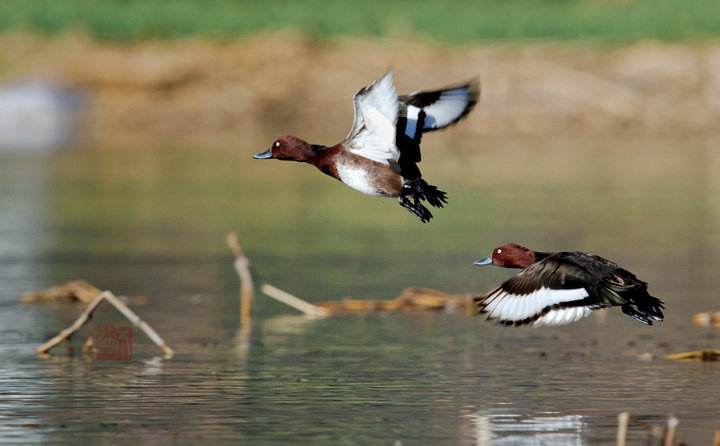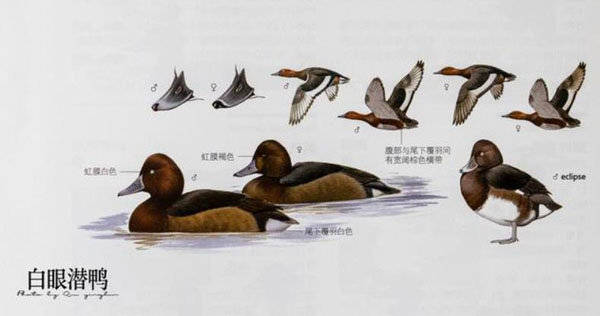Aythya nyroca
IUCN
LCBasic Information
Scientific classification
- name:Aythya nyroca
- Scientific Name:Ferruginous Duck,White-eyed Pochard,Ferruginous Pochard
- Outline:Waterfowl
- Family:Anseriformes Anatidae Aythya
Vital signs
- length:Males 371-430 mm, females 330-410 mm
- Weight:Male 550-750g, female 490-650g
- lifetime:8 year
Feature
Pochards are very good at diving, but they do not stay underwater for long. They often move around in waters rich in reeds and aquatic plants and lurk in them.
Distribution and Habitat
Distributed in Afghanistan, Albania, Algeria, Armenia, Austria, Azerbaijan, Bangladesh, Belarus, Belgium, Bhutan, Bosnia and Herzegovina, Bulgaria, Central African Republic, Chad, China, Croatia, Cyprus, Czech Republic, Egypt, Eritrea, Ethiopia, France, Gambia, Georgia, Germany, Greece, Hungary, India, Islamic Republic of Iran, Iraq, Israel, Italy, Jordan, Kazakhstan, Kuwait, Kyrgyzstan, Latvia, Lebanon, Libya, Liechtenstein, Lithuania, Luxembourg, Macedonia, Mali, Malta, Mauritania, Moldova, Mongolia, Montenegro, Morocco, Myanmar, Nepal, Netherlands, Niger, Nigeria, Oman, Pakistan, Palestine, Poland, Portugal, Qatar, Romania, Russian Federation, Saudi Arabia, Senegal, Serbia, Slovakia, Slovenia, South Sudan, Spain, Sudan, Switzerland, Syrian Arab Republic, Tajikistan, Thailand, Tunisia, Turkey, Turkmenistan, Ukraine, United Arab Emirates, United States, Uzbekistan, Vietnam, Yemen, Sahara.
Migrant birds: Bahrain, Benin, Bermuda, Burkina Faso, Cape Verde, Denmark, Finland, Ghana, Hon
Appearance
The male white-eyed pochard has a dark chestnut head and neck, with a small triangular white spot on the chin; there is a distinct dark brown collar ring on the neck. The upper body is dark brown, with inconspicuous brown worm-like spots on the upper back and shoulders, or with brown edges. The secondary flight feathers and the inner primary flight feathers are white, with dark brown tips, forming a wide white wing mirror and a dark brown horizontal band on the rear edge of the wing mirror; the outer primary flight feathers have dark brown tips and feather edges; the tertiary flight feathers are dark brown with a green luster. The upper coverts of the waist and tail are black. The breast is dark chestnut, the flanks are chestnut brown, the upper abdomen is white, the lower abdomen is light brown, the sides of the anus are black, and the lower tail coverts are white.
The female bird has a brown head and neck, darker top of the head and neck, a small triangular white spot on the chin,
Details
As a male white-eyed pochard, it is born with a pair of bean-sized white eyes, which are particularly prominent against the dark chestnut head. Therefore, whenever people see male white-eyed pochards, they are always "rolling their eyes", which gives people a sense of "looking at life with cold eyes". Female white-eyed pochards have very "normal" eyes and will not "roll their eyes".

The white-eyed pochard is a typical freshwater pochard in the southern Palearctic. It is very good at diving, but it does not stay underwater for long. It often moves on the surface of water rich in reeds and aquatic plants and lurks in it. It is timid and alert, often moving in pairs or small groups, and only gathers in larger groups during the molting period and migration period after breeding.
The threats to the species mainly come from the pressure of environmental degradation, wetland environmental pollution, degradation and destruction caused by human activities and construction, and further habitat degradation caused by alien species. Other threats include hunting, lead poisoning and hybridization with other species.

Listed in the Red List of Endangered Species of the World Conservation Union (IUCN), the level is Near Threatened (NT).
Listed in the "National List of Terrestrial Wildlife with Important Economic and Scientific Research Value" (item 61) issued by the State Forestry Administration of China on August 1, 2000.
In October 2020, the State Forestry and Grassland Administration issued the "Notice on Standardizing the Classification and Management Scope of Prohibited Wildlife" on its official website. For 45 species of wild animals such as white-eyed pochards, the "Notice" clearly requires that relevant breeders should be actively guided to stop breeding activities before the end of December 2020 and complete the disposal work in accordance with relevant regulations. If it is necessary to retain a moderate amount of seed sources for non-edible purposes such as scientific research, the feasibility of the work plan should be fully demonstrated and the relevant procedures should be strictly followed.
Protect wild animals and eliminate game, they do not belong on the table.








